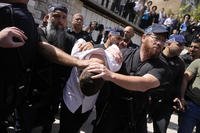
The vulnerabilities, components and processes used to make armor are rarely discussed with reporters, or the general public. Keeping those things secret saves soldiers lives. So when the Armys testing community rolled out the services top armor scientists and allowed us glimpses of the facilities used to make armor as part of our FCS tour at Aberdeen Proving Ground they sent a very clear message of the importance they attach to this enormous program.
After a briefing by two top Army materiel scientists, the group of reporters trudged in to a large room that looked like a cross between a package wrapping station for a small mail-order company (big rolls of flat and bubbly plastics) and an enormous art studio, with several giant presses and kilns dominating the structure. Everyones heard of ceramic armor and Kevlar, but few have seen the seemingly ordinary stuff that helps make armor really effective. The two scientists had laid out on a big metal table more than a dozen samples of various armor components. One mat roughly the size of a dinner table mat looked like woven glass fibers. There was a roll of something that felt and looked remarkably like magnetic tape. Of course, there was a ceramic substance that had been shattered in some sort of ballistic test. Next to it was a big thick wad (maybe three inches thick) of surprisingly light aluminum.
Ernie Chin, from the Army Research Laboratory, told us that some armor variants involve ceramics or other materials bonded to metal matrices (of which there were several examples including one that looked a lot like a honeycomb), perhaps with layers of glass, plastics or other more exotic materials. The whole point is, how do we put all this together, he said.
All these materials had apparently been used in the search to create the B armor for FCS. They are using what is called B-1 armor now and plan to come up with two more variants, using B-3 as the main armor once the FCS vehicles make it to LRIP in fiscal 2013.B-1 provides, a very careful public affairs officer told me, protection roughly equivalent to the Chobham armor on the Abrams tanks. The next variants should be much lighter and provide even greater protection.
After peering knowingly at all this stuff, we headed out by bus to the real world, where we saw battered evidence of the progression the scientists have marched along with the testing community. Past a guarded (and very tall) gate, out past very uninhabited portions of Maryland wetlands and forests we rolled past a few battered-looking MRAPs to a very large set of armored targets for ballistic projectiles.
These included early versions of the FCS armor that were bolted on to an aluminum inner hull, a fact that Col. Gregory Martin, chief of the Armys J-8 directors initiative group, told us was revolutionary because it would allow armor to be swapped on vehicles as the armor is improved instead of the current state of the art which only allows so-called appliqu armor to be put on top of the existing stuff. The scientists talking us through these test targets said all the armors and the improvements made to them had performed well or extremely well. Of course, we couldnt expect them to share the exact vulnerabilities and performance characteristics of the armor, though several of us tried?
One of the wow moments during the initial armor briefing came when the Armys top armor researcher, Chris Hoppel, told us that the modeling they do on exactly how and why armor performs during a test would occupy a personal computer for about one year. Using various government supercomputers, the Army can get the job done overnight.
-- Colin Clark








